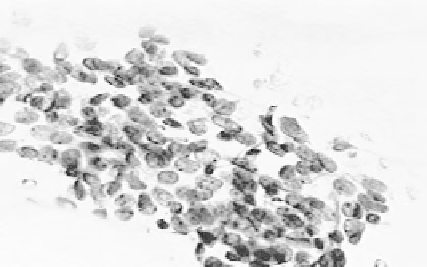Image Processing Reference
In-Depth Information
is adopted. For these two cases the system expects a complete pre-classified training set.
Fuzzy rule generation with clustering and learning by examples in contact endoscopy is
presented in Section6.4.3.
Computer-aided diagnosis in medical imaging can be defined as a diagnosis that is made
by a physician who uses the output from computerised analysis of medical images as a
“second opinion” in the process of making diagnostic decisions. This automated second
opinion is formed on the basis of medical image data. The diagnostic system related to
image understanding should cover all aspects of low-level processing to high-level data
recognition/interpretation. Diagnostic accuracy depends not only on the quality of data
interpretation but also on data acquisition.
6.4.1
Breast cancer diagnosis based on histopathology
The first application where we evaluate the fuzzy classifier is the diagnosis of breast cancer
based on images of fine needle aspirates (
see Fig. 6.7
for an example image (Street, Wolberg,
and Mangasarian, 1993)).
FIGURE 6.7: Image of fine needle aspirates of breast mass
Fluid samples were extracted with a fine needle from the patient's breast mass, placed
on a glass slide and stained to highlight the nuclei of constituent cells (Street et al., 1993).
From the captured images, a number of features was extracted as follows. First, curve-fitting
techniques were applied to detect boundaries of the nuclei. For each nucleus 10 features
were extracted, namely radius, standard deviation of gray-scale values, perimeter, area,
smoothness (local variation in radius lengths), compactness, concavity, number of concave
parts, symmetry and fractal dimension. The mean, standard deviation and maximum values
of these features over all nuclei in the image were then calculated to provide a feature vector
with 30 values (Street et al., 1993). In total the dataset comprises 569 samples of which 357
are known to constitute benign and the remaining 212 malignant cases. Since there are two
classes (i.e. benign and malignant), we examined the performance of fuzzy classifiers with
three weight assignment: benign focussed (1.0 for benign patterns and 0.5 for malignant
patterns), malignant focussed (1.0 for malignant patterns and 0.5 for benign patterns),
and class-proportional. 10-fold cross validation was performed where the given data set
is divided into ten subsets and each subset is used as test data set while the other nine
data sets are used as training patterns.
The experimental results, expressed in terms of



Search WWH ::

Custom Search